weight HONDA CIVIC SEDAN 2011 Owner's Manual (in English)
[x] Cancel search | Manufacturer: HONDA, Model Year: 2011, Model line: CIVIC SEDAN, Model: HONDA CIVIC SEDAN 2011Pages: 390, PDF Size: 6.95 MB
Page 27 of 390
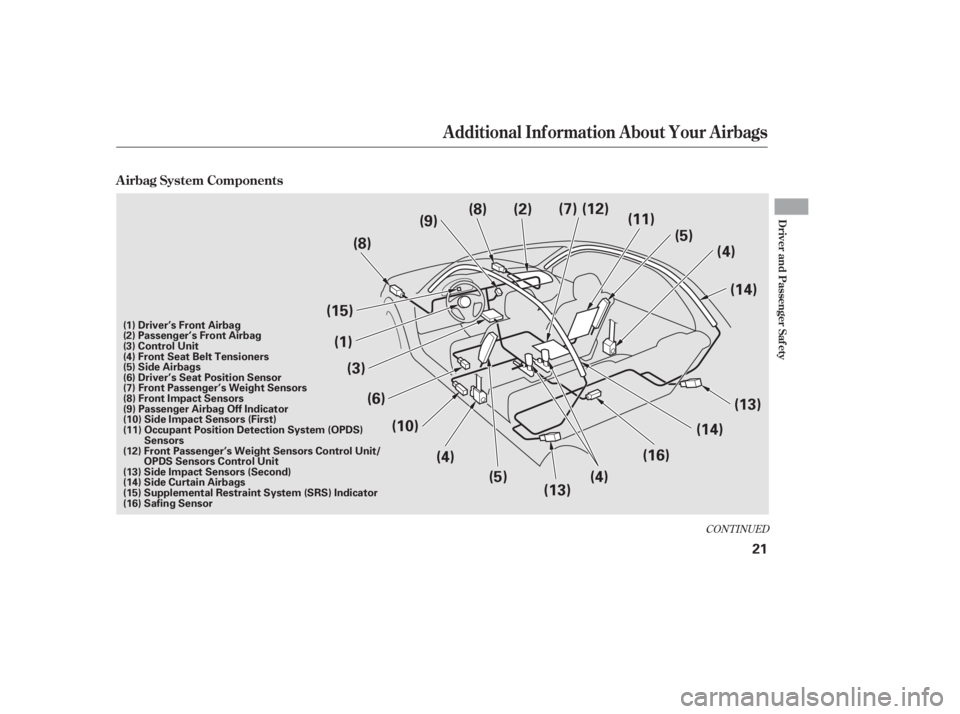
CONT INUED
A irbag System Components
Additional Inf ormation About Your Airbags
Driver and Passenger Saf ety
21
(9)
(1) (3) (14)
(4)
(6) (11)
(14)
(10)
(13)
(8)
(15) (12)
(7)
(5)(4)
(13)
(16)
(4)
(5)
(8)
(2)
(5) Side Airbags
(6) Driver’s Seat Position Sensor
(7) Front Passenger’s Weight Sensors
(1) Driver’s Front Airbag
(2) Passenger’s Front Airbag
(3) Control Unit
(4) Front Seat Belt Tensioners
(15) Supplemental Restraint System ( SRS) Indicator
(16) Safing Sensor (8) Front Impact Sensors
(9) Passenger Airbag Off Indicator
(10) Side Impact Sensors (First)
(11) Occupant Position Detection System (OPDS)
Sensors
(12) Front Passenger’s Weight Sensors Control Unit/ OPDS Sensors Control Unit
(13) Side Impact Sensors (Second)
(14) Side Curtain Airbags
10/06/23 13:52:07 31SNA650_026
Page 29 of 390
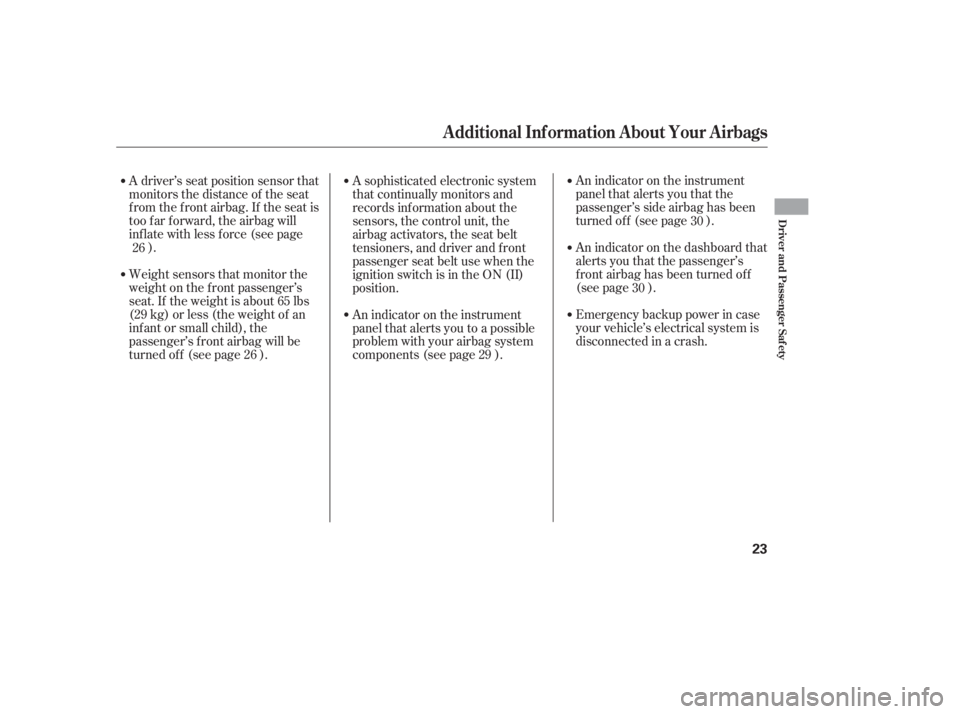
An indicator on the instrument
panel that alerts you that the
passenger’s side airbag has been
turned of f (see page ).
An indicator on the dashboard that
alerts you that the passenger’s
f ront airbag has been turned of f
(see page ).
Emergency backup power in case
your vehicle’s electrical system is
disconnected in a crash.
A driver’s seat position sensor that
monitors the distance of the seat
from the front airbag. If the seat is
too f ar f orward, the airbag will
inf late with less f orce (see page
).
Weight sensors that monitor the
weight on the f ront passenger’s
seat. If the weight is about 65 lbs
(29 kg) or less (the weight of an
inf ant or small child), the
passenger’s f ront airbag will be
turned of f (see page ). A sophisticated electronic system
that continually monitors and
records inf ormation about the
sensors, the control unit, the
airbag activators, the seat belt
tensioners, and driver and f ront
passenger seat belt use when the
ignition switch is in the ON (II)
position.
An indicator on the instrument
panel that alerts you to a possible
problem with your airbag system
components (see page ).
26
26 29 30
30
Additional Inf ormation About Your Airbags
Driver and Passenger Saf ety
23
10/06/23 13:52:23 31SNA650_028
Page 32 of 390
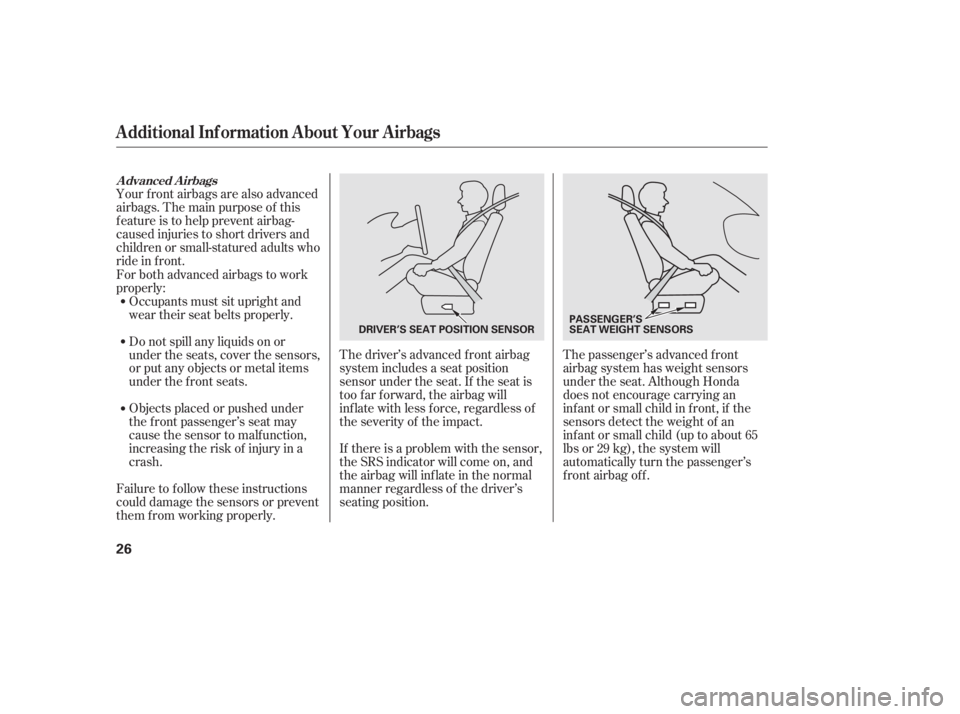
The driver’s advanced front airbag
system includes a seat position
sensor under the seat. If the seat is
too f ar f orward, the airbag will
inf late with less f orce, regardless of
the severity of the impact.
Your f ront airbags are also advanced
airbags. The main purpose of this
feature is to help prevent airbag-
caused injuries to short drivers and
children or small-statured adults who
ride in f ront.
If there is a problem with the sensor,
the SRS indicator will come on, and
the airbag will inf late in the normal
manner regardless of the driver’s
seating position.The passenger’s advanced f ront
airbag system has weight sensors
under the seat. Although Honda
does not encourage carrying an
inf ant or small child in f ront, if the
sensors detect the weight of an
inf ant or small child (up to about 65
lbs or 29 kg), the system will
automatically turn the passenger’s
front airbag off.
For both advanced airbags to work
properly:
Failure to f ollow these instructions
could damage the sensors or prevent
them f rom working properly. Occupants must sit upright and
wear their seat belts properly.
Objects placed or pushed under
the f ront passenger’s seat may
cause the sensor to malf unction,
increasing the risk of injury in a
crash. Do not spill any liquids on or
under the seats, cover the sensors,
or put any objects or metal items
under the f ront seats.
Advanced Airbags
Additional Inf ormation About Your Airbags
26
PASSENGER’S
SEAT WEIGHT SENSORS
DRIVER’S SEAT POSITION SENSOR
10/06/23 13:52:51 31SNA650_031
Page 33 of 390
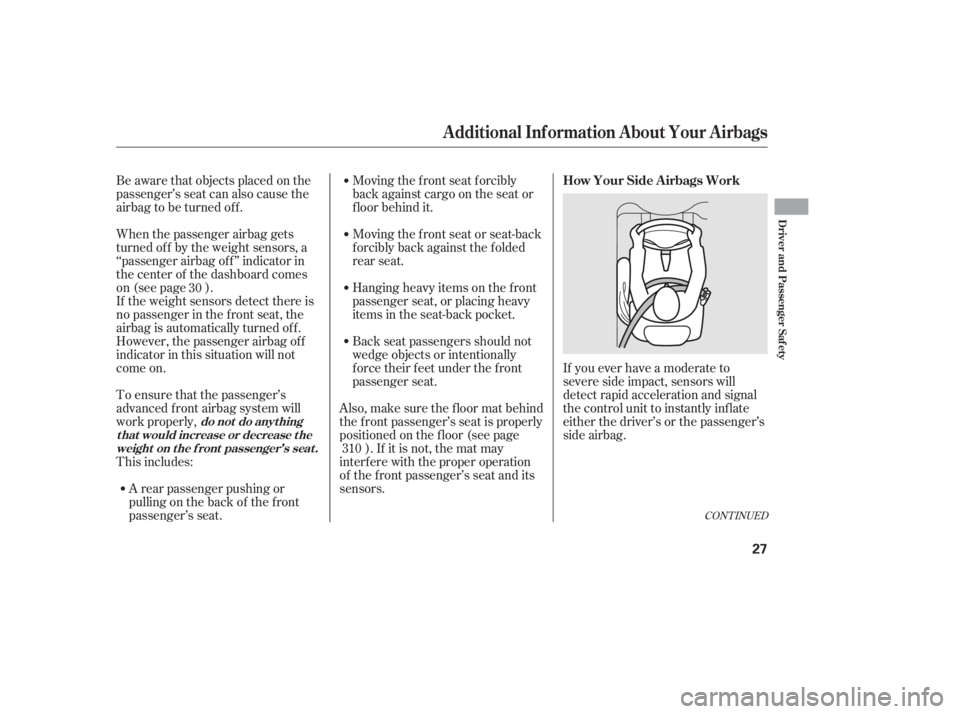
Moving the f ront seat f orcibly
back against cargo on the seat or
f loor behind it.
Moving the front seat or seat-back
f orcibly back against the f olded
rear seat.
Be aware that objects placed on the
passenger’s seat can also cause the
airbag to be turned off.
If the weight sensors detect there is
no passenger in the f ront seat, the
airbag is automatically turned off.
However, the passenger airbag of f
indicator in this situation will not
come on. When the passenger airbag gets
turned of f by the weight sensors, a
‘‘passenger airbag of f ’’ indicator in
the center of the dashboard comes
on (see page ). Hanging heavy items on the f ront
passenger seat, or placing heavy
items in the seat-back pocket.
If you ever have a moderate to
severe side impact, sensors will
detect rapid acceleration and signal
the control unit to instantly inf late
either the driver’s or the passenger’s
side airbag.
Back seat passengers should not
wedge objects or intentionally
f orce their f eet under the f ront
passenger seat.
Also,makesurethefloormatbehind
the f ront passenger’s seat is properly
positioned on the f loor (see page ). If it is not, the mat may
interf ere with the proper operation
of the f ront passenger’s seat and its
sensors.
To ensure that the passenger’s
advanced front airbag system will
work properly,
This includes:
A rear passenger pushing or
pulling on the back of the f ront
passenger’s seat. 30
310
CONT INUED
How Your Side A irbags Work
Additional Inf ormation About Your Airbags
do not do anyt hing
t hat would increase or decrease t he weight on the f ront passenger’s seat.
Driver and Passenger Saf ety
27
10/06/23 13:53:03 31SNA650_032
Page 36 of 390
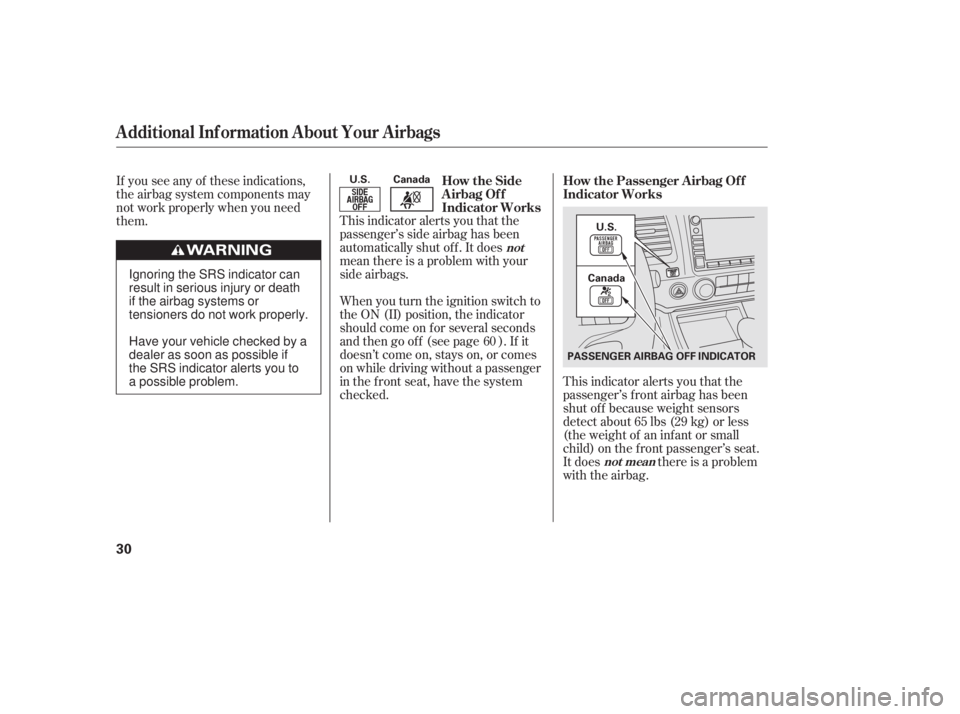
This indicator alerts you that the
passenger’s f ront airbag has been
shut of f because weight sensors
detect about 65 lbs (29 kg) or less
(the weight of an inf ant or small
child) on the f ront passenger’s seat.
It does there is a problem
with the airbag.
This indicator alerts you that the
passenger’s side airbag has been
automatically shut off. It does
mean there is a problem with your
side airbags.
When you turn the ignition switch to
the ON (II) position, the indicator
should come on f or several seconds
andthengooff (seepage ).If it
doesn’t come on, stays on, or comes
on while driving without a passenger
in the front seat, have the system
checked.
If you see any of these indications,
the airbag system components may
not work properly when you need
them.
60How the Passenger Airbag Of f
Indicator Works
How the Side
Airbag Of f
Indicator Works
Additional Inf ormation About Your Airbags
not mean
not
30
Canada
U.S.
PASSENGER AIRBAG OFF INDICATOR
U.S. CanadaIgnoring the SRS indicator can
result in serious injury or death
if the airbag systems or
tensioners do not work properly.
Have your vehicle checked by a
dealer as soon as possible if
the SRS indicator alerts you to
a possible problem.
10/06/23 13:53:38 31SNA650_035
Page 37 of 390
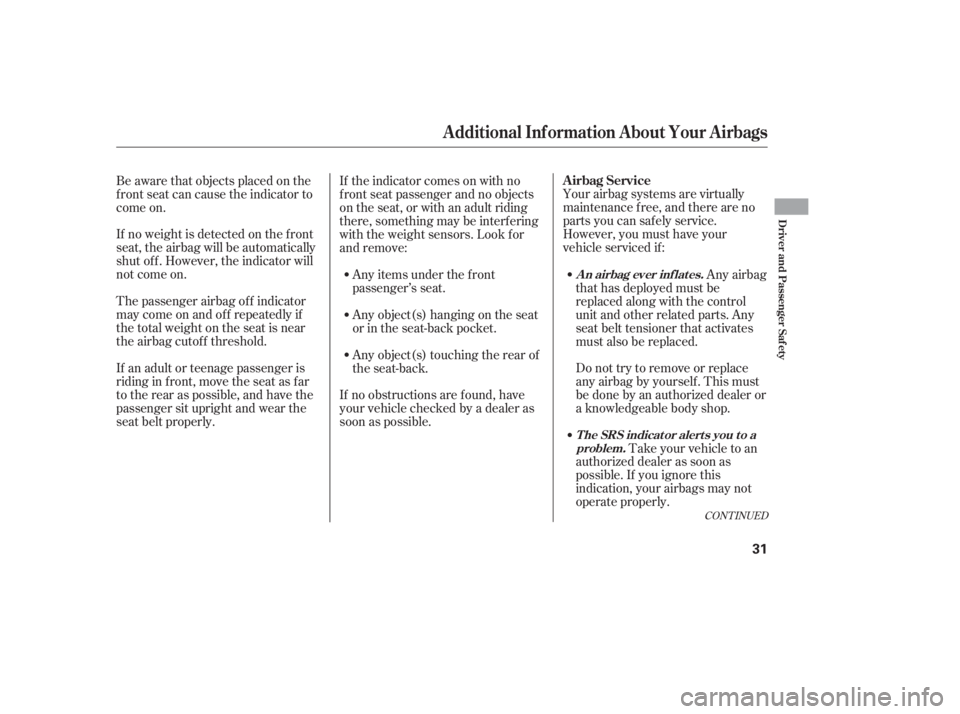
Take your vehicle to an
authorized dealer as soon as
possible. If you ignore this
indication, your airbags may not
operate properly.
Your airbag systems are virtually
maintenance f ree, and there are no
parts you can saf ely service.
However, you must have your
vehicle serviced if:
Do not try to remove or replace
anyairbagbyyourself.Thismust
be done by an authorized dealer or
a knowledgeable body shop.
Be aware that objects placed on the
f ront seat can cause the indicator to
come on.
If no weight is detected on the f ront
seat, the airbag will be automatically
shut of f . However, the indicator will
not come on.
The passenger airbag of f indicator
maycomeonandoff repeatedlyif
the total weight on the seat is near
the airbag cutof f threshold.
If an adult or teenage passenger is
riding in f ront, move the seat as f ar
to the rear as possible, and have the
passenger sit upright and wear the
seat belt properly. If the indicator comes on with no
f ront seat passenger and no objects
on the seat, or with an adult riding
there, something may be interf ering
with the weight sensors. Look f or
and remove:
Any airbag
that has deployed must be
replaced along with the control
unit and other related parts. Any
seat belt tensioner that activates
must also be replaced.
Any items under the f ront
passenger’s seat.
Any object(s) hanging on the seat
or in the seat-back pocket.
Any object(s) touching the rear of
the seat-back.
If no obstructions are f ound, have
your vehicle checked by a dealer as
soon as possible.
CONT INUED
Additional Inf ormation About Your Airbags
T he SRS indicat or alert s you t o a problem.
An airbag ever inf lates.
Airbag Service
Driver and Passenger Saf ety
31
10/06/23 13:53:52 31SNA650_036
Page 38 of 390
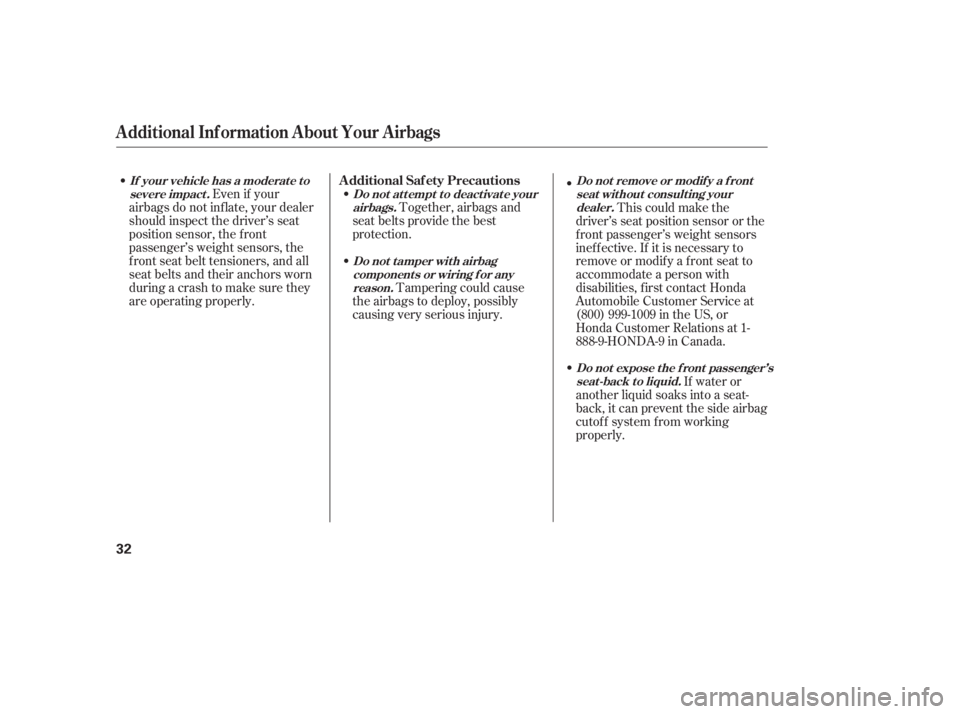
Together, airbags and
seat belts provide the best
protection.
Tampering could cause
the airbags to deploy, possibly
causing very serious injury.
Even if your
airbags do not inflate, your dealer
should inspect the driver’s seat
position sensor, the f ront
passenger’s weight sensors, the
f ront seat belt tensioners, and all
seat belts and their anchors worn
during a crash to make sure they
are operating properly. This could make the
driver’s seat position sensor or the
f ront passenger’s weight sensors
inef f ective. If it is necessary to
remove or modif y a f ront seat to
accommodate a person with
disabilities, f irst contact Honda
Automobile Customer Service at
(800) 999-1009 in the US, or
Honda Customer Relations at 1-
888-9-HONDA-9 in Canada.
If water or
another liquid soaks into a seat-
back, it can prevent the side airbag
cutof f system f rom working
properly.
Additional Inf ormation About Your Airbags
Additional Saf ety Precautions
Donotattempttodeactivateyour
airbags.
Do not t amper wit h airbagcomponent s or wiring f or anyreason.
If your vehicle has a moderat e t o
severe impact . Do not remove or modif y a f ront
seat without consulting yourdealer.
Do not expose the f ront passenger’sseat-back to liquid.
32
10/06/23 13:54:00 31SNA650_037
Page 44 of 390
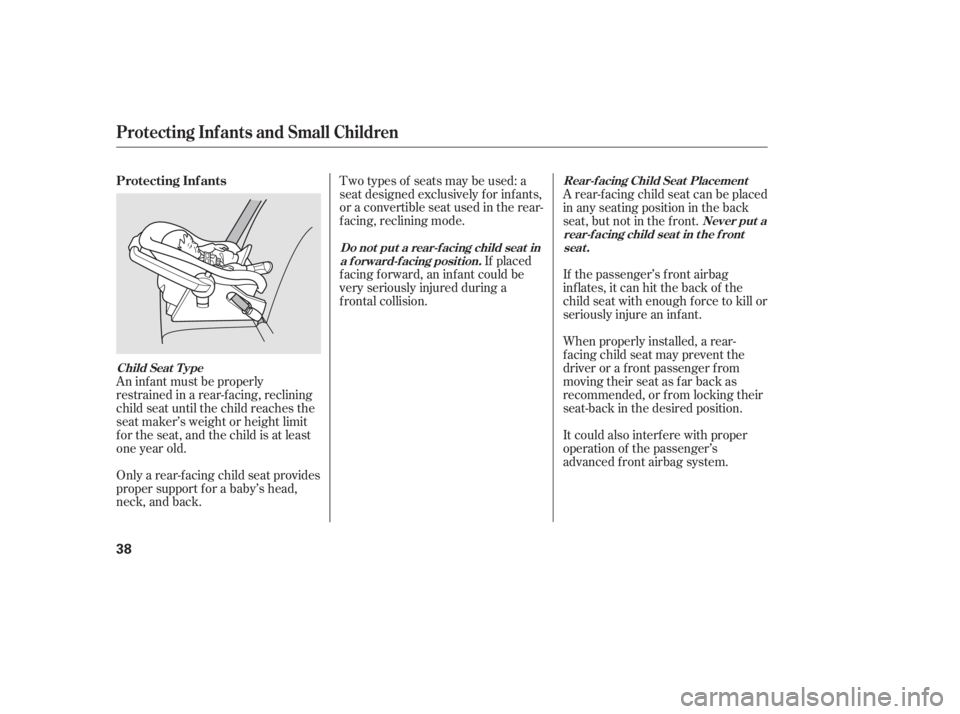
An inf ant must be properly
restrained in a rear-f acing, reclining
child seat until the child reaches the
seat maker’s weight or height limit
f or the seat, and the child is at least
one year old.
Only a rear-f acing child seat provides
proper support f or a baby’s head,
neck, and back.Two types of seats may be used: a
seat designed exclusively f or inf ants,
or a convertible seat used in the rear-
f acing, reclining mode.
If placed
f acing f orward, an inf ant could be
very seriously injured during a
f rontal collision. A rear-f acing child seat can be placed
in any seating position in the back
seat, but not in the f ront.
If the passenger’s front airbag
inflates, it can hit the back of the
child seat with enough f orce to kill or
seriously injure an inf ant.
When properly installed, a rear-
f acing child seat may prevent the
driver or a f ront passenger f rom
moving their seat as far back as
recommended, or f rom locking their
seat-back in the desired position.
It could also interf ere with proper
operation of the passenger’s
advanced front airbag system.
Protecting Inf ants
Child Seat T ype
Do not put a rear-f acing child seat in
a f orward-f acing position. Never put a
rear-f acing child seat in t he f ront seat .
Rear-f acing Child Seat Placement
Protecting Inf ants and Small Children
38
10/06/23 13:55:12 31SNA650_043
Page 45 of 390
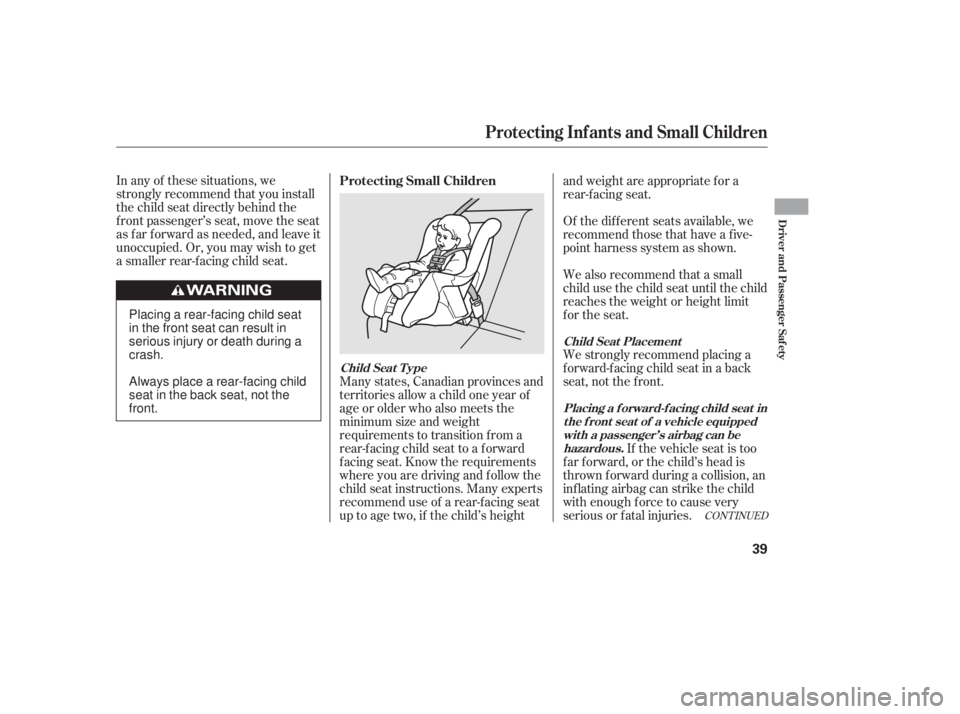
CONT INUED
In any of these situations, we
strongly recommend that you install
the child seat directly behind the
f ront passenger’s seat, move the seat
as far forward as needed, and leave it
unoccupied. Or, you may wish to get
a smaller rear-f acing child seat.Many states, Canadian provinces and
territories allow a child one year of
age or older who also meets the
minimum size and weight
requirements to transition f rom a
rear-facing child seat to a forward
f acing seat. Know the requirements
where you are driving and follow the
child seat instructions. Many experts
recommend use of a rear-f acing seat
up to age two, if the child’s heightand weight are appropriate f or a
rear-facing seat.
If the vehicle seat is too
f ar f orward, or the child’s head is
thrown f orward during a collision, an
inf lating airbag can strike the child
with enough force to cause very
serious or fatal injuries. We strongly recommend placing a
forward-facing child seat in a back
seat, not the f ront. We also recommend that a small
child use the child seat until the child
reaches the weight or height limit
for the seat. Of the different seats available, we
recommend those that have a f ive-
point harness system as shown.
Protecting Small Children
Child Seat T ype
Placing a f orward-f acing child seat inthe f ront seat of a vehicle equippedwith a passenger’s airbag can behazardous.
Child Seat Placement
Protecting Inf ants and Small Children
Driver and Passenger Saf ety
39
Placing a rear-facing child seat
in the front seat can result in
serious injury or death during a
crash.
Always place a rear-facing child
seat in the back seat, not the
front.
10/06/23 13:55:24 31SNA650_044
Page 51 of 390
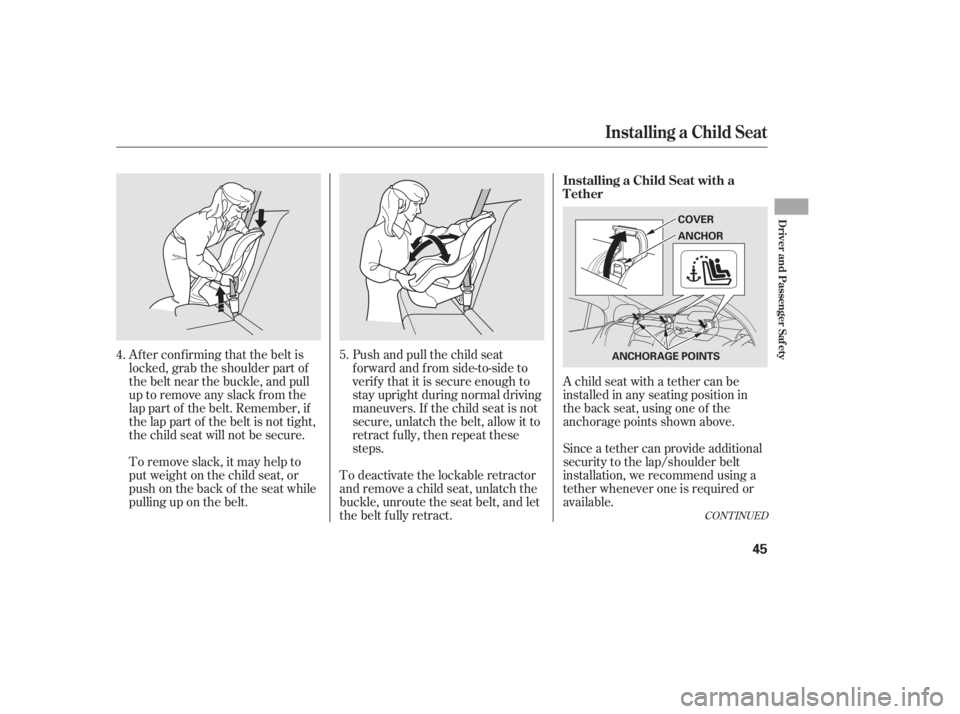
Af ter conf irming that the belt is
locked, grab the shoulder part of
the belt near the buckle, and pull
up to remove any slack from the
lap part of the belt. Remember, if
the lap part of the belt is not tight,
the child seat will not be secure.Push and pull the child seat
f orward and f rom side-to-side to
verify that it is secure enough to
stay upright during normal driving
maneuvers. If the child seat is not
secure, unlatch the belt, allow it to
retract f ully, then repeat these
steps.
To remove slack, it may help to
putweightonthechildseat,or
push on the back of the seat while
pulling up on the belt. To deactivate the lockable retractor
and remove a child seat, unlatch the
buckle, unroute the seat belt, and let
the belt fully retract. Since a tether can provide additional
security to the lap/shoulder belt
installation, we recommend using a
tether whenever one is required or
available. A child seat with a tether can be
installed in any seating position in
the back seat, using one of the
anchorage points shown above.
4. 5.
CONT INUED
Installing a Child Seat with a
Tether
Installing a Child Seat
Driver and Passenger Saf ety
45
ANCHORAGE POINTS COVER
ANCHOR
10/06/23 13:56:26 31SNA650_050